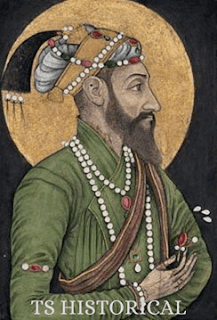Aurangzeb Alamgir | History, Age, Death & Facts
Muhiuddin Muhammad (3 November 1618 – 3 March 1707), commonly known as Aurangzeb or Alamgir (a royal name given by Muslim subjects meaning world conqueror), was the sixth Mughal ruler to rule India. His reign lasted from 1658 until his death in 1707. Aurangzeb ruled the Indian subcontinent for almost half a century. He was the longest-reigning Mughal ruler after Akbar. During his lifetime, he tried hard to expand the Mughal Empire in southern India, but after his death, the Mughal Empire began to shrink.
The Mughal Empire reached the peak of its expansion
under Aurangzeb's rule. He was probably the richest and most powerful man of
his time. During his lifetime, through his conquests in some states of South
India, the Mughal Empire spread over twelve and a half million square miles and
ruled over 150 million people, which was 1/4 of the world's population.
Aurangzeb imposed a Shariat-based
Fatwa-e-Alamgiri on the entire empire and for some time imposed more taxes on
non-Muslims. He was the first Muslim ruler to impose Shari'a on non-Muslim
subjects. He had killed Guru Tegh Bahadur of the Sikhs.
Aurangzeb Alamgir early life
Aurangzeb was born on 3 November 1618 in Dahod, Gujarat. He was the sixth child and third son of Shah Jahan and Mumtaz Mahal. His father was the Subedar of Gujarat at that time. When his father's rebellion failed in June 1626, Aurangzeb and his brother Dara Shukoh were taken hostage by Nur Jahan in their grandfather Jahangir's Lahore court. When Shah Jahan was proclaimed the Mughal Emperor on 26 February 1628, Aurangzeb returned to live with his parents at the Agra Fort. It was here that Aurangzeb received his formal education in Arabic and Persian.
Aurangzeb enter power
In accordance with Mughal customs, Shah
Jahan appointed Prince Aurangzeb as the Subedar of the Deccan in
1634. Aurangzeb went to Khadki (Maharashtra) which he renamed as Aurangabad. In
1637 he married Rabia Durrani. Here Shah Jahan started handing over the affairs
of the Mughal court to his son Dara Shikoh. Aurangzeb's sister died in an
accident in 1644. Aurangzeb came to Agra three weeks after this incident which
made his father Shah Jahan very angry with him. He suspended Aurangzeb from the
post of Subedar of Deccan. Aurangzeb did not come to the court for 7 months.
Later Shah Jahan made him the Subedar of Gujarat. Aurangzeb ruled smoothly and
he also got the result, he was made the governor of Badakhshan (North
Afghanistan) and the Balkh (Afghan-Uzbek) region.
After this, he was also made the Subedar of
Multan and Sindh. During this, he kept fighting for control of Kandahar with
the Safavids of Persia, but he got something other than defeat, it was the
neglect of his father. In 1652, he was again made the Subedar of the Deccan. He
fought against Golconda and Bijapur and at the crucial moment, Shah Jahan
withdrew from the army. This hurt Aurangzeb a lot because Shah Jahan was doing
this at the behest of his brother Dara Shikoh.
Aurangzeb Alamgir Banned music
In an attempt to prove Aurangzeb a fanatic, a
big argument is also made that he banned music, but this is also not true.
Catherine tells that even in the Sultanate, music was not banned even in the
court. Every year on the day the emperor ascended the throne, there was a lot
of dancing and singing in the festival. Some of the Dhrupads include the name
Aurangzeb which suggests that music was patronized during his reign. Some
historical facts also point towards the fact that he himself was well versed in
music. In Mirat-e-Alam, Bakhtawar Khan has written that the emperor had the
knowledge of music masters. The Mughal scholar Faqirullah has recorded the
names of Aurangzeb's favorite singers and instrumentalists in a document called
Raga Darpan. Azam Shah was very dear to Aurangzeb among his sons and history
tells that Shah had become an accomplished musician during his father's
lifetime.
Talking about the flourishing of music during
Aurangzeb's reign, Catherine writes, 'Aurangzeb's time had the most
commentaries on music in Persian, compared to the entire Mughal period of 500
years. Although it is true that towards the end of his life, Aurangzeb had
become more religious and had distanced himself from songs and music. But in
view of what we have mentioned above, it can be assumed that he never made his
personal will the official policy of the Sultanate.
Death of Aurangzeb Alamgir
In the last days of Aurangzeb, the Maratha
power in the south had increased tremendously. The imperial army was not
getting success in suppressing them. Therefore, in 1683, Aurangzeb himself went
south with an army. He remained in the same campaign for the last 25 years of
his reign, living away from the capital. After ruling for 50 years, he died in
Ahmednagar of the South on 3 March 1707 AD. He was buried in the compound of
the tomb of Fakir Buruhanuddin located in Daulatabad. His policy created so
many opponents, due to which the Mughal Empire came to an end. Although
Aurangzeb considered himself the emperor of the Hindu place and had a lot of
wealth, he had different ideas about his own grave. He wrote about his own
grave in such a way that it should be made very simple. His grave is located in
Khuldabad, Aurangabad district.


Comments
Post a Comment